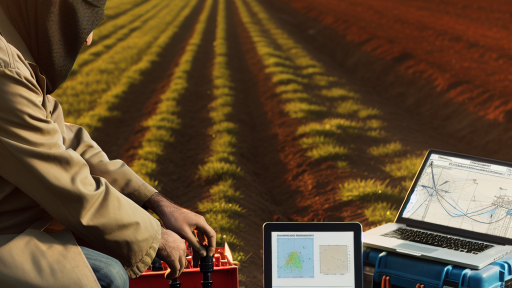Introduction to Crop Rotation
Definition of Crop Rotation
Crop rotation involves alternating different crops in the same field across seasons.
This practice helps maintain soil fertility and structure.
It also reduces pest and disease cycles.
Importance of Crop Rotation
Crop rotation is vital for sustainable agriculture.
It enhances biodiversity within farming systems.
Moreover, it helps in nutrient conservation.
Healthy crop rotation can significantly improve soil health.
Farmers experience better crop yields over time.
Economic Benefits
Implementing crop rotation can reduce input costs.
Diverse crops may require fewer chemical fertilizers and pesticides.
This approach can lead to increased profitability.
Environmental Impact
Crop rotation fosters better water management.
It promotes soil erosion prevention and conservation.
This method also contributes to carbon sequestration in the soil.
The Principles of Sustainable Agriculture: Connecting to Crop Rotation
Defining Sustainable Agriculture
Sustainable agriculture emphasizes harmony between agricultural practices and environmental health.
Transform Your Agribusiness
Unlock your farm's potential with expert advice tailored to your needs. Get actionable steps that drive real results.
Get StartedThis approach seeks to balance economic viability with ecological integrity.
Farmers use sustainable methods to produce food while conserving resources.
Importance of Soil Health
Soil health is a core principle of sustainable agriculture.
It enhances crop productivity and resilience against diseases.
Farmers achieve soil health by employing practices like crop rotation.
Certain crops improve soil structure and nutrient content.
Biodiversity in Farming Systems
Diversifying crops boosts ecosystem resilience.
It attracts beneficial insects and enhances pollination.
Increased biodiversity also helps manage pests naturally.
Economic Stability
Farmers benefit economically from sustainable practices.
By reducing dependency on chemical inputs, costs decrease.
Moreover, sustainable practices can lead to market advantages.
Consumers increasingly prefer sustainably produced goods.
Integrating Crop Rotation
Crop rotation is a vital strategy supporting sustainable agriculture.
This practice involves alternating different crops on the same land.
It prevents soil nutrient depletion and reduces pest buildup.
Certain crop combinations can promote healthy soil ecosystems.
For example, legumes enrich soil nitrogen levels naturally.
Long-term Sustainability Goals
Sustainable agriculture aims for long-term food security.
It addresses challenges posed by climate change effectively.
Crop rotation contributes towards achieving these overarching goals.
Farmers who employ these techniques can ensure a stable future.
Common Crop Rotation Planning Methods
Understanding Crop Rotation
Crop rotation involves changing the type of crop grown in a specific area each season.
This method enhances soil fertility and disrupts pest cycles.
Showcase Your Farming Business
Publish your professional farming services profile on our blog for a one-time fee of $200 and reach a dedicated audience of farmers and agribusiness owners.
Publish Your ProfileBy implementing crop rotation, farmers can significantly improve their yields.
Types of Crop Rotation Strategies
Sequential Crop Rotation
Sequential crop rotation involves planting different crops in a specific order.
This strategy focuses on crop compatibility and soil nutrient management.
Farmers often rotate deep-rooted and shallow-rooted plants for optimal results.
Intercropping
Intercropping combines different crops in the same field at the same time.
This method maximizes space and promotes beneficial interactions between plants.
For instance, legumes can improve soil nitrogen while growing alongside grains.
Cover Cropping
Cover cropping involves planting crops that do not get harvested.
These cover crops protect the soil and enhance its structure and fertility.
They also reduce erosion and suppress weeds during off-seasons.
Benefits of Crop Rotation
Crop rotation enhances soil health through natural nutrient replenishment.
This practice minimizes the risk of pests and diseases associated with monoculture.
Moreover, it leads to better water retention and soil structure improvement.
Implementing a Crop Rotation Plan
Creating an effective crop rotation plan requires careful planning and observation.
Farmers should consider factors like local climate and soil conditions.
Additionally, they must analyze previous crop performance and market demand.
Utilizing Technology in Crop Rotation
Modern technology aids farmers in designing efficient crop rotation systems.
Data-driven tools can assess soil health and predict suitable crops.
Such innovations promote informed decisions and optimized agricultural practices.
See Related Content: Sustainable Livestock Housing Design Principles And Tips
Benefits of Crop Rotation
Soil Health
Crop rotation significantly enhances soil health.
It improves soil structure and fertility over time.
This practice reduces soil erosion caused by monoculture.
Moreover, rotating crops helps replenish essential nutrients.
Legumes, for instance, fix nitrogen in the soil.
Consequently, this leads to improved crop yields.
Biodiversity
Crop rotation promotes greater biodiversity in agriculture.
It supports various plant species within the same area.
This diversity can attract beneficial insects and pollinators.
Additionally, different crops can foster various microbial communities.
As a result, this strengthens the overall ecosystem health.
Pest Management
Effective pest management is a key benefit of crop rotation.
Changing crops disrupts the lifecycle of pests and diseases.
For example, certain pests thrive on specific crops.
When farmers rotate to a non-host crop, pest numbers decline.
Thus, crop rotation reduces the reliance on chemical pesticides.
This approach ultimately contributes to sustainable agriculture.
Find Out More: Conserving Biodiversity in Agricultural Landscapes
Factors to Consider in Crop Rotation Planning
Understanding Climate Impact
The local climate significantly influences crop rotation decisions.
Farmers must assess temperature ranges for optimal growth.
Showcase Your Farming Business
Publish your professional farming services profile on our blog for a one-time fee of $200 and reach a dedicated audience of farmers and agribusiness owners.
Publish Your ProfilePrecipitation patterns also affect crop selection and success.
Additionally, understanding frost dates helps in planning planting schedules.
Soil Type Considerations
Soi type plays a critical role in crop rotation strategies.
Farmers need to analyze soil structure, texture, and nutrient content.
Certain crops thrive in specific soil conditions, impacting rotation choices.
Regular soil tests provide valuable data for informed decision-making.
Assessing Market Demand
Market demand should guide crop rotation planning effectively.
Farmers must research current trends and consumer preferences.
Diverse crops can help mitigate risks associated with market fluctuations.
Vendor relationships also inform viable crop choices for profitability.
Integrating All Factors
A successful crop rotation plan integrates climate, soil, and market data.
Balancing these elements fosters sustainable agricultural practices.
Farmers should continually adapt their strategies based on changing conditions.
This adaptive planning promotes resilience and long-term success in farming.
Uncover the Details: Creating Habitats to Support Farm Biodiversity

Case Studies: Successful Crop Rotation Practices in Different Regions
North American Practices
In the Midwest, farmers use a corn-soybean rotation system.
This practice enhances soil health and increases yield.
For example, the Williams Family Farm has reported a 20% increase in corn yield since adopting this method.
Furthermore, the rotation reduces pest populations significantly.
Farmers benefit from improved profitability and sustainability.
European Innovations
In France, mixed cropping has gained popularity.
Farmers combine cereals and legumes in their rotations.
This strategy enhances nitrogen fixation and soil fertility.
Jean-Pierre Martin’s farm exemplifies this approach with impressive results.
He boasts of reduced fertilizer costs and healthier crops.
Asian Techniques
In India, rice-wheat cropping systems dominate agriculture.
Farmers like Anjali Kumar practice intensive crop rotations.
This method improves land use efficiency and income stability.
Moreover, it helps in managing water resources effectively.
Farmers are increasingly adopting organic practices to enhance soil quality.
African Experiences
In Kenya, the use of intercropping is prevalent.
Farmers grow maize alongside beans to diversify their production.
Mary Njuguna has successfully increased her family’s food security this way.
This rotation helps in pest control and maximizing space utilization.
Additionally, it fosters sustainable land management practices.
Australian Solutions
In Australia, farmers employ diverse rotations, including pasture and cash crops.
This helps maintain soil moisture and improves biodiversity.
Greg Thompson’s farm demonstrates how this approach can lead to economic resilience.
He experiences lower input costs and increased crop resilience against drought.
Moreover, the farm’s environmental impact is significantly reduced.
Showcase Your Farming Business
Publish your professional farming services profile on our blog for a one-time fee of $200 and reach a dedicated audience of farmers and agribusiness owners.
Publish Your ProfileGain More Insights: Reducing Farm Waste with Green Technologies
Technology in Crop Rotation Planning
Utilizing Modern Software Tools
Farmers can significantly enhance crop rotation planning with modern software tools.
These tools provide valuable insights into soil health and crop performance.
For instance, platforms like CropTracker offer comprehensive data management solutions.
Farmers can track crop history and plan future rotations effectively using such software.
Additionally, many tools integrate weather forecasts to optimize planting schedules.
Benefits of Mobile Applications
Mobile applications simplify access to crop rotation information for farmers.
Farmers can utilize apps like AgriSync to communicate with agronomists easily.
Such communication helps farmers make informed decisions about planting sequences.
Moreover, apps can send timely alerts regarding pest threats or disease outbreaks.
Data Analytics for Improved Decision-Making
Data analytics plays a crucial role in crop rotation planning.
Advanced analytics tools analyze historical data to forecast crop yields.
Farmers can leverage platforms like FarmLogs to assess environmental conditions.
These evaluations guide farmers in selecting the best crops for specific conditions.
Consequently, this leads to enhanced harvests and reduced risk of crop failure.
Drip Irrigation and Precision Farming
Employing technologies like drip irrigation aids in efficient water resource management.
This method ensures crops receive optimum water tailored to their needs.
Next, precision farming tools enable farmers to apply fertilizers and pesticides selectively.
This targeted application minimizes waste and supports sustainable practices.
Integrating GIS Technology
Geographic Information Systems (GIS) enhance visualization of field data.
Farmers can map soil characteristics and fertility levels across their fields.
Such insights allow for more precise crop rotation strategies based on actual conditions.
Furthermore, GIS helps identify zones that may require special management techniques.
Collaboration Platforms for Knowledge Sharing
Collaboration platforms foster knowledge sharing among farmers and experts.
Networks like the Sustainable Agriculture Research and Education (SARE) offer valuable resources.
Farmers can participate in discussions and acquire best practices in crop rotation.
Consequently, this community-driven approach enhances collective knowledge and sustainability.
Challenges in Implementing Crop Rotation
Understanding Adoption Barriers
Many farmers face challenges when implementing crop rotation.
These challenges can stem from financial constraints.
Additionally, a lack of knowledge can hinder adoption.
Furthermore, traditional farming practices often dominate.
Financial Constraints
Initial costs of transitioning can be substantial.
Farmers often worry about losing income during the shift.
Financial assistance programs may help alleviate this concern.
Moreover, economic incentives can encourage rotation practices.
Lack of Knowledge and Training
Some farmers lack sufficient training in crop rotation.
Access to educational resources is crucial for success.
Community workshops can enhance farmers’ understanding.
Partnering with agricultural experts can also help.
Traditional Practices and Cultural Resistance
Many farms have long histories of specific practices.
Showcase Your Farming Business
Publish your professional farming services profile on our blog for a one-time fee of $200 and reach a dedicated audience of farmers and agribusiness owners.
Publish Your ProfileChanging these ingrained habits can be difficult.
Promoting awareness of crop rotation benefits is essential.
Farmers need support from their communities to shift perspectives.
Environmental and Climatic Factors
Climate variability can complicate crop planning.
Regions may experience unexpected weather patterns.
Farmers must adapt their rotations accordingly.
Research can help identify suitable crops for varying conditions.
Overcoming Barriers to Adoption
Addressing these challenges requires a multi-faceted approach.
Collaboration among stakeholders is key to success.
Policy changes can facilitate better resource access.
Additionally, education and outreach are vital for farmers.
Finally, showcasing successful case studies can inspire change.




